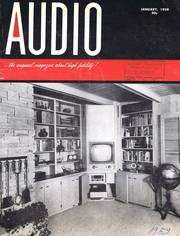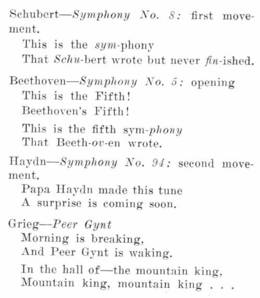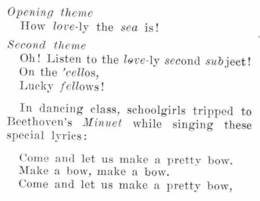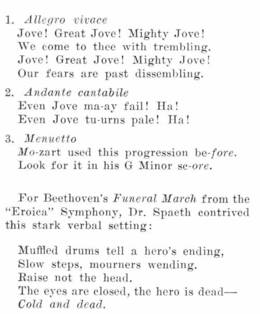Erläuterungen zu diesen US-AUDIO Seiten der 1950er Jahre
Die hier stehenden amerikanischen Artikel aus 1959 (aus der US-AUDIO) sind teilweise sehr gewöhnungsbedürftig, weil sie erstens aus einer längst vergangenen Zeit stammen und zweitens, weil dort in den USA ganz "anders" gedacht wurde als bei uns in Old Germany oder in Europa.
Vergleichbar mit unseren deutschen Hifi-Magazinen etwa ab 1962 ist jedoch, daß auch dieses Audio-Magazin ihre Anzeigen- Kunden und -Leser am Markt oder von anderen Magazinen (be- oder ab- ?) werben mußte. - Weiterhin sind die riesigen Dimensionen des amerikanischen Kontinents mit unseren hier in Europa nicht vergleichbar. - Ein Redaktions-"Trip" von New York nach Los Angeles oder Chicago oder gar in die Wüste nach Las-Vegas zu einer der CES- Audio- "Shows" war - auch mit dem Flugzeug - immer noch eine halbe Weltreise. Und jede Ausstellung oder "Messe" wurde als "Show" deklariert. Und natürlich, in USA musste alles "Show" sein, um beim Publikum einige Aufmerksamkeit zu erzeugen.
.
ABOUT MUSIC - "Let's Sing a Symphony"
Leonard Bernstein's last television appearance of the season (February 22 1959) was titled, "The Infinite Variety of Music," but it could have been called, "Variations on How Dry I Am."
The New York Philharmonic conductor took the first four notes of the familiar drinking tune and showed us how Handel, Beethoven, Strauss, and Shostakovitch used this particular sequence in their compositions. "How Dry I Am" was heard in the major and minor keys, as well as in a variety of moods ranging from the festive, to the lyric, playful, romantic and martial. Before the program was over, one found oneself yearning for a good stiff drink.
To exclaim how wonderful it is that a composer can express so many different things by means of an alphabet of twelve notes tells us very little about the art of music. After all, the composer performs no less a miracle than the writer with his twenty-six letters, the painter with his three primary colors, or the mathematician with his nine integers.
Having once enunciated his thought, Mr. Bernstein would have done well to have gone on to more substantial areas. Instead, he chose to repeat his theme without alteration, thereby turning his program into a reverberating platitude. He is too talented and versatile to indulge in an approach that smacks of the "music appreciation" class, which many of us will remember from our public school days.
The music appreciation period in the week's schedule usually involved marching into the assembly hall to the tune of Sousa's King Cotton, or Washington Post, played vigorously on the piano by the music teacher.
Most students regarded this as the easiest class in their curriculum; they rested comfortably in the auditorium's less battered seats and listened to recordings of classical music played on a portable phonograph. Between recorded selections, the teacher picked out melodies from the compositions on the program. The educational objective was simple: to learn great music by remembering themes from famous works. Teachers long ago discovered the obvious fact that mere exposure to classical music will put most of their classes to sleep. (A glance at the audiences at symphony concerts demonstrates that this holds true even for ticket-paying adults.) Therefore, they had to devise a method for engaging the students' full attention.
.
The association of words and music
The association of words and music seemed the answer to the problem. In memorizing a sentence or a poem linked with a melody from a popular symphonic piece, it stands to reason that the student will memorize the music, too. This proved a practical scheme. Too practical, in fact. For no matter how much we now try to eradicate these words from our mind, they cling to us with the tenacity that only certain youthful memories are wont to possess.
Before proceeding further, the reader should be warned that this subject has its contagious aspects. How often have we been pursued by a tune from which we cannot escape? This writer, like thousands of music lovers who attended the same kind of music appreciation classes, has had certain words inscribed indelibly in his memory alongside themes from great musical scores.
Here are a few examples.
Schubert - Symphony No. 8: first movement.
This is the sym-phony
That Schu-bert wrote but never fin-ished.
Beethoven - Symphony No. 5: opening
This is the Fifth!
Beethoven's Fifth!
This is the fifth sym-phony
That Beeth-ov-en wrote.
Haydn - Symphony No. 94; second movement.
Papa Haydn made this tune
A surprise is coming soon.
Grieg - Peer Gynt
Morning is breaking,
And Peer Gynt is waking.
In the hall of - the mountain king,
Mountain king, mountain king . . .
.
Some of the best specimens of music-appreciation poetry are written in England, where one music educator set to words the themes of the entire Well-Tempered Clavier. English school-children remember Mendelssohn's Hebrides Overture by means of the following lines:
.
Opening theme
How love-ly the sea is!
Second theme
Oh! Listen to the love-ly second swfcject! On the 'cellos, Lucky fellowsl
In dancing class, schoolgirls tripped to Beethoven's Minuet while singing these special lyrics:
Come and let us make a pretty bow.
Make a bow, make a bow.
Come and let us make a pretty bow,
Make a pretty stylish, fancy turn.
Now we'll walk off so straight,
Make a bow, make a bo-ow.
Come and let us make a pretty bow.
Make a bow, vis-a-vis.
.
In his book, "Great Symphonies - how to recognize and remember them" (Comet Press), Sigmund Spaeth, the high priest of music appreciation, sets to words the principal and subsidiary themes of well known symphonies. With impressive determination, Dr. Spaeth performs verbal acrobatics in order to make the words fit the tune. Take, for example, his settings of Mozart's Jupiter Symphony.
.
1. Allegro vivace
Jove! Great Jove! Mighty Jove!
We come to thee with trembling.
Jove ! Great Jove ! Mighty Jove !
Our fears are past dissembling.
2. Andante cantaoile
Even Jove ma-ay fail! Ha!
Even Jove tu-urns pale! Ha!
3. Menuetto
Mo-zart used this progression be-fore.
Look for it in his G Minor sc-ore.
For Beethoven's Funeral March from the "Eroica" Symphony, Dr. Spaeth contrived this stark verbal setting:
Muffled drums tell a hero's ending, Slow steps, mourners wending. Raise not the head. The eyes are closed, the hero is dead - Cold and dead.
In the above examples, Dr. Spaeth built his poems on a title or an implied program. He was greatly handicapped by such a work as Mozart's Symphony No. 39, which bears no subtitle and has no extra-musical allusions:
.
First movement
E Flat the key.
Great symphony.
.
.
Dr. Spaeth's comprehensiveness, however, proves to be his undoing, for how is one to recognize the themes of great symphonies when the key words are too numerous and difficult to remember? The concise phrase used in the public schools may serve to highlight only one theme per work - and often merely part of the theme - but it is a simple phrase.
Which brings us back to "How Dry I Am." Mr. Bernstein's purpose in using this drinking song differs from that of the music appreciation teacher. Yet he has unwittingly injected an element of uncertainty into the field, for "How Dry I Am," while a handy identity key, now stands for several different pieces. In addition, the words do not refer specifically to the music in question, with the possible exception of Handel's Water Music.
In view of the confusion, perhaps this would be a good time to end the practice of writing lyrics to great musical works once and for all. Did Mendelssohn anticipate the era of music appreciation when he composed his "Songs Without Words"?
AE








